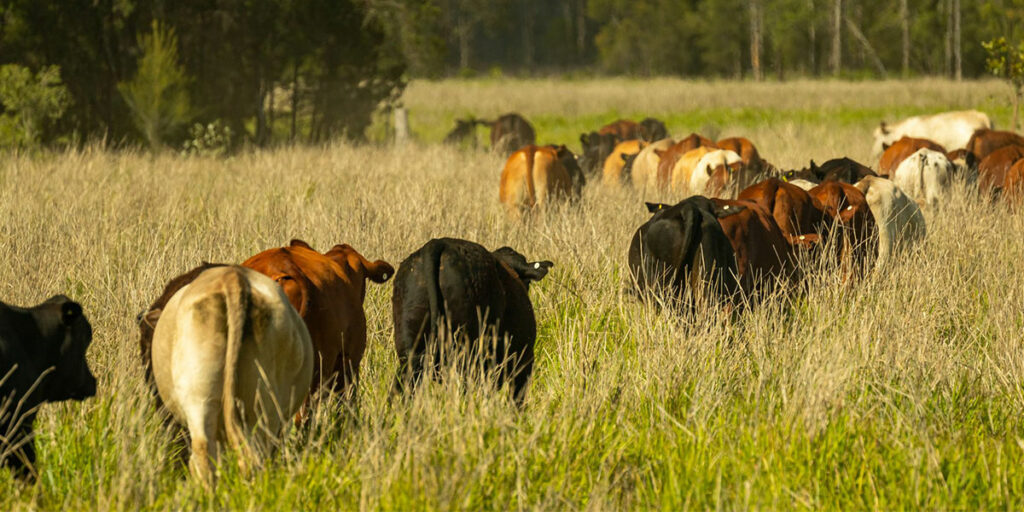Charlie Hawkins explains the basic principles of soil carbon farming.
You’ve likely heard about soil carbon farming, but what is it?
What is soil carbon farming?
Soil carbon farming is the process of improving your soil health through better management of pasture through the grazing animal, or better management of cultivation products or cultivars through better soil management. The soil carbon farming process involves (in a grazing system) ensuring that you’ve got live pasture throughout the year, because the living plant will have a living root mass, which will have mycorrhizal fungi, which will promote anion and cation exchange capacity, which allows the root mass to access trace elements that are necessary for plant life. And the mycorrhizal fungi promote humus, and then humus creates organic matter. Organic matter turns into soil carbon. And soil carbon not only provides access to the trace minerals, but it has greater moisture holding capacity, so greater resistance to drought and greater resilience from drought.
What is an ACCU?
An ACCU or an Australian Carbon Credit Unit is how we measure how much carbon dioxide is taken out of the atmosphere through carbon farming or avoided going into the atmosphere through a carbon farming activity. One ACCU is valued somewhere between $25 and $35. It’s a financial instrument created by the Australian government to support the carbon farming market. It’s what you get paid for, the rewards of carbon farming, when you sequester carbon or avoid carbon dioxide emissions going into the atmosphere.
How is an ACCU Measured?
To measure an ACCU, you have to have a method of carbon farming that has a measurable component to it. The soil carbon farming method is about measuring soil carbon change over time. In the beginning of a soil carbon project, we baseline, or we measure the soil carbon content on different parts of your property. And then in five years, we come back, and we look at the change. The soil carbon is tested via an instrument in our laboratory in Gladstone.
There are other ways of measuring soil carbon, for instance, with reduction in emissions intensity with beef cattle, and that is measured by change in liveweight gain. You baseline your herd’s liveweight gain over the last three years and then through the seven years of the project, if you’re increasing the live weight gain, you’re reducing emissions intensity by reducing the age it takes for that animal to get to sale weight. So, there are fewer molecules of methane per kilogram produced. That’s a reduction in emissions intensity measured through statistics. So carbon is measured through physical measurement of the soil.
What is the ERF?
The Emissions Reduction Fund is a $2.5 Billion fund that initiated the Australian carbon market back in 2015 or 2014 with bipartisan support. The Carbon Farming Act was created by Penny Wong in 2013, and from that the Emissions Reduction Fund was built to support the initiation of carbon farming projects. Initially, the Australian government was buying all of the carbon credits, and that’s what the fund was supporting carbon farming projects would enter into options where they would have an opportunity to create a price and a volume of carbon credits to sell to the government, and the government would opt to take on that contract. Now, the carbon market has expanded to the private sector via the safeguard mechanism, where heavy emitters are penalised if they emit over a certain threshold of carbon emissions and they have to buy Australian carbon credit units.
How does it link to Regenerative Agriculture?
Soil carbon farming directly relates to regenerative agricultural principles because regenerative agricultural principles are about rejuvenating the landscape, about making the landscape healthier and stronger, more resistant to drought and resilient from drought. A resilient farming system or cattle production system will have good pasture cover all year round, good living root mass that’s creating that organic matter in the soil, retaining soil moisture in the soil and enabling pasture to continue to grow so the grazing animal can continue to thrive through the year, increasing its liveweight gain. Regenerative cultivation practises are about reducing synthetic inputs into the system, encouraging the root mass to grow deep for that mycorrhizal fungi again to expand and for that microbial activity to go crazy, to enable access to different trace elements that are necessary for the plant’s growth.
How do I start carbon farming?
To begin carbon farming first speak to a carbon project service provider who is signatory to the carbon code of conduct. It’s very important that you speak to someone who’s part of the code of conduct, because by being signatories, we are obliged to provide producers with all the information they need to know about what’s involved in getting into carbon farming, the risks and the successes of going through a project, because they’re long projects between 30 and 100 hundred years.
For more information on how we can help you with soil carbon farming complete an enquiry form on our contact page.



